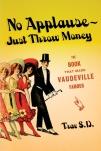 Much like certain other terms we have explored here (e.g. burlesque), “cabaret” is a word with more than one meaning, evoking more than one milieu. These are the two that spring to mind:
Much like certain other terms we have explored here (e.g. burlesque), “cabaret” is a word with more than one meaning, evoking more than one milieu. These are the two that spring to mind:
EUROPE, BEFORE THE SECOND WORLD WAR
In 1881, the same year that Tony Pastor opened his music hall in New York, a painter name Rodolphe Salis started the first “cabaret artistique” in Paris, called the Chat Noir, after an Edgar Allan Poe story. “Cabaret” is French for “tavern”. Salis used the term to suggest that his entertainments took the form of a menu or a bill of fare, offering songs, dances, sketches, poetry readings, shadow plays and the like. in it’s wake came the Moulin Rouge and the Folies Bergère, and many others.
Before long, the cabaret movement had spread to all the major European cities. In 1901, several influential cabarets opened in Berlin, thus inaugurating the cultural scene familiar to readers of Christopher Isherwood’s Berlin Stories and its dramatic adaptations I Am a Camera and Cabaret. That year also the Elf Scharfrichter (the “Eleven Executioners”) opened in Munich, where Frank Wedekind (author of the Lulu plays, including Spring Awakening) sang songs to his guitar, and where one act plays, songs, dances, puppet dramas, and musical instrumentals were presented. In 1916, Hans Arp and Tristan Tsara founded the Cabaret Voltaire in Zurich, where Dada (the cultural movement that was precursor to surrealism) was born. At their events, someone might scream poems from inside a large sack, insult the audience, growl like a bear, draw a moustache on a copy of the Mona Lisa or perform other senseless, random acts of violence. In 1935 the Nazis banned Cabaret in Germany, and later in all their conquered territories. They preferred to perform all the senseless, random acts of violence themselves.
Interestingly, this original movement never caught hold in the English-speaking world, presumably because the prevailing Puritanism frowned so heavily on anything so overtly anti-establishment. Not that there was nothing artistic about American variety and British music hall — quite the contrary. But the English and Americans were never self-conscious about it. Vaudeville never declared itself to be “art” and it was never bohemian. Far from allying itself with an outsider stance, it was the very channel thousands sought for mainstream fame and acceptance.
The version of this original cabaret movement that came to the U.S. in the nineteen-teens became for the most part what we call “night clubs” — strictly show biz. We’ll take about them in our next post.
CONTEMPORARY AMERICAN CABARET
Since the Second World War, in America the word has also attached itself to a certain kind of small club or piano bar, where jazz and sometimes stand-up comedy are presented on elevator-sized stages. Such venues were the launching places of artists like Tony Bennett, comedienne Judy Holiday, or singer/pianist Bobby Short. New York still boasts countless such venues, the Duplex and Triad being prominent among them. In many ways the artists who regularly perform in such clubs can lay as great a claim or greater than circus or sideshow artists to perpetuating the vaudeville tradition.
To learn more about the variety arts past and present, including cabaret entertainment, consult No Applause, Just Throw Money: The Book That Made Vaudeville Famous, available at Amazon, Barnes and Noble, and wherever books are sold.

